外研版八年级上册Module 2 Unit 2 Cambridge is a beautiful city in the east of England.教案
文档属性
| 名称 | 外研版八年级上册Module 2 Unit 2 Cambridge is a beautiful city in the east of England.教案 |

|
|
| 格式 | docx | ||
| 文件大小 | 17.1KB | ||
| 资源类型 | 教案 | ||
| 版本资源 | 外研版 | ||
| 科目 | 英语 | ||
| 更新时间 | 2024-02-27 19:39:22 | ||
图片预览


文档简介
外研版八年级上册Module 2 Unit 2 Cambridge is a beautiful city in the east of England.教案
I. Teaching Objectives:
By the end of this lesson, students will be able to:
1. Understand and use prepositions of place.
2. Describe the location of places using prepositions.
3. Identify and pronounce geographical locations correctly.
4. Use context clues to understand the meaning of new words related to geography.
5. Expand vocabulary related to cities, regions, and countries.
6. Enhance listening skills by understanding a description of Cambridge's location.
7. Develop speaking skills through discussions on the location of different places.
8. Write sentences or a short paragraph describing the location of a city or town.
9. Appreciate the cultural and historical significance of Cambridge as a city.
II. Key Vocabulary:
- Prepositions of place (e.g., in, on, to, at).
- Nouns representing cities, regions, and countries (e.g., Cambridge, England, Europe).
- Adjectives for describing places (e.g., beautiful, old, famous).
- Verbs associated with exploring or talking about places (e.g., visit, see, explore).
III. Target Language Structures:
- Prepositions of place including 'in', 'on', 'to', 'at', etc., and how they are used to describe locations.
- The formation and usage of questions with prepositions (e.g., Where is Cambridge ).
- Answering questions about location using prepositions correctly.
- Use of definite articles 'the' with geographical locations.
IV. Teaching Aids:
- Maps of the world, Europe, and England to help students locate Cambridge.
- Pictures or slides showcasing landmarks and features of Cambridge.
- Whiteboard and markers for grammar explanation and writing key sentences.
- Audio material featuring a description of Cambridge's location and its features.
- Handouts with exercises on using prepositions of place and writing prompts for describing locations.
V. Teaching Procedures:
Step 1: Warm-up (5 minutes)
- Start with a brainstorming activity where students list famous cities they know.
- Elicit key vocabulary from students and write it on the board.
Step 2: Listening (10 minutes)
- Play an audio track that describes the location of Cambridge and its features.
- After listening, ask comprehension questions to check understanding of Cambridge's location.
Step 3: Speaking Practice (15 minutes)
- Students work in pairs to discuss the location of their own city/town using prepositions of place.
- Conduct a class activity where students take turns describing the location of famous cities using maps and prepositions.
Step 4: Grammar Focus (10 minutes)
- Review the usage of prepositions of place and how they relate to describing locations.
- Introduce and practice common questions and answers using prepositions (e.g., Where is... It's in/on/to...).
- Teach the correct use of articles with geographical locations.
Step 5: Writing (10 minutes)
- Distribute worksheets with exercises on using prepositions of place and writing prompts for describing locations.
- Assign a written task where students describe the location of their hometown or a known city using prepositions correctly.
Step 6: Homework & Review (5 minutes)
- Assign homework for students to complete their writing task, incorporating feedback from the writing exercise.
- Review key points from the lesson through a quick quiz or verbal questioning.
VI. Assessment:
- Evaluate students based on their participation in speaking activities, correct usage of prepositions of place in oral and written assignments, and completion of homework tasks.
- Assess listening skills through comprehension questions related to the audio content about Cambridge's location.
- Assess speaking abilities through pair discussions and the ability to describe locations accurately using prepositions.
- Review the ability to write clear sentences describing locations using appropriate prepositions and articles.
I. Teaching Objectives:
By the end of this lesson, students will be able to:
1. Understand and use prepositions of place.
2. Describe the location of places using prepositions.
3. Identify and pronounce geographical locations correctly.
4. Use context clues to understand the meaning of new words related to geography.
5. Expand vocabulary related to cities, regions, and countries.
6. Enhance listening skills by understanding a description of Cambridge's location.
7. Develop speaking skills through discussions on the location of different places.
8. Write sentences or a short paragraph describing the location of a city or town.
9. Appreciate the cultural and historical significance of Cambridge as a city.
II. Key Vocabulary:
- Prepositions of place (e.g., in, on, to, at).
- Nouns representing cities, regions, and countries (e.g., Cambridge, England, Europe).
- Adjectives for describing places (e.g., beautiful, old, famous).
- Verbs associated with exploring or talking about places (e.g., visit, see, explore).
III. Target Language Structures:
- Prepositions of place including 'in', 'on', 'to', 'at', etc., and how they are used to describe locations.
- The formation and usage of questions with prepositions (e.g., Where is Cambridge ).
- Answering questions about location using prepositions correctly.
- Use of definite articles 'the' with geographical locations.
IV. Teaching Aids:
- Maps of the world, Europe, and England to help students locate Cambridge.
- Pictures or slides showcasing landmarks and features of Cambridge.
- Whiteboard and markers for grammar explanation and writing key sentences.
- Audio material featuring a description of Cambridge's location and its features.
- Handouts with exercises on using prepositions of place and writing prompts for describing locations.
V. Teaching Procedures:
Step 1: Warm-up (5 minutes)
- Start with a brainstorming activity where students list famous cities they know.
- Elicit key vocabulary from students and write it on the board.
Step 2: Listening (10 minutes)
- Play an audio track that describes the location of Cambridge and its features.
- After listening, ask comprehension questions to check understanding of Cambridge's location.
Step 3: Speaking Practice (15 minutes)
- Students work in pairs to discuss the location of their own city/town using prepositions of place.
- Conduct a class activity where students take turns describing the location of famous cities using maps and prepositions.
Step 4: Grammar Focus (10 minutes)
- Review the usage of prepositions of place and how they relate to describing locations.
- Introduce and practice common questions and answers using prepositions (e.g., Where is... It's in/on/to...).
- Teach the correct use of articles with geographical locations.
Step 5: Writing (10 minutes)
- Distribute worksheets with exercises on using prepositions of place and writing prompts for describing locations.
- Assign a written task where students describe the location of their hometown or a known city using prepositions correctly.
Step 6: Homework & Review (5 minutes)
- Assign homework for students to complete their writing task, incorporating feedback from the writing exercise.
- Review key points from the lesson through a quick quiz or verbal questioning.
VI. Assessment:
- Evaluate students based on their participation in speaking activities, correct usage of prepositions of place in oral and written assignments, and completion of homework tasks.
- Assess listening skills through comprehension questions related to the audio content about Cambridge's location.
- Assess speaking abilities through pair discussions and the ability to describe locations accurately using prepositions.
- Review the ability to write clear sentences describing locations using appropriate prepositions and articles.
同课章节目录
- Module 1 How to learn English
- Unit 1 Let's try to speak English as much as possi
- Unit 2 You should smile at her.
- Unit 3 Language in use .
- Module 2 My home town and my country
- Unit 1 It's taller than many other buildings.
- Unit 2 Cambridge is a beautiful city in the east o
- Unit 3 Language in use .
- Module 3 Sports.
- Unit 1 Nothing is more exciting than playing tenni
- Unit 2 This year we training more carefully.
- Unit 3 Language in use .
- Module 4 Planes, ships and trains .
- Unit 1 He lives the farthest from school.
- Unit 2 What is the best way to travel.
- Unit 3 Language in use .
- Module 5 Lao She Teahouse.
- Unit 1 I wanted to see the Beijing Opera.
- Unit 2 It descibes the changes in Chinese society.
- Unit 3 Language in use .
- Module 6 Animals in danger.
- Unit 1 It allows people to get closer to them .
- Unit 2 The WWF is working hard to save them all.
- Unit 3 Language in use .
- Revision module A
- Module 7 A famous story
- Unit 1 Alice was sitting with her sister by the ri
- Unit 2 She was thinking about her cat.
- Unit 3 Language in use .
- Module 8 Accidents
- Unit 1 While the car were changing to red, a car s
- Unit 2 I was trying to pick it up when it bite me
- Unit 3 Language in use .
- Module 9 Population
- Unit 1 The population of China is about 1.37 billi
- Unit 2 Arnwick was a city with 200,000 people.
- Unit 3 Language in use .
- Module 10 The weathe
- Unit 1 It might snow.
- Unit 2 The weather is fine all year round.
- Unit 3 Language in use .
- Module 11 Way of life
- Unit 1 In China ,we open a gift later.
- Unit 2 In England, you usually drink tea with milk
- Unit 3 Language in use .
- Module 12 Help
- Unit 1 What should we do before help arrives?
- Unit 2 Stay away from windows and heavy furniture.
- Unit 3 Language in use .
- Revision module B
